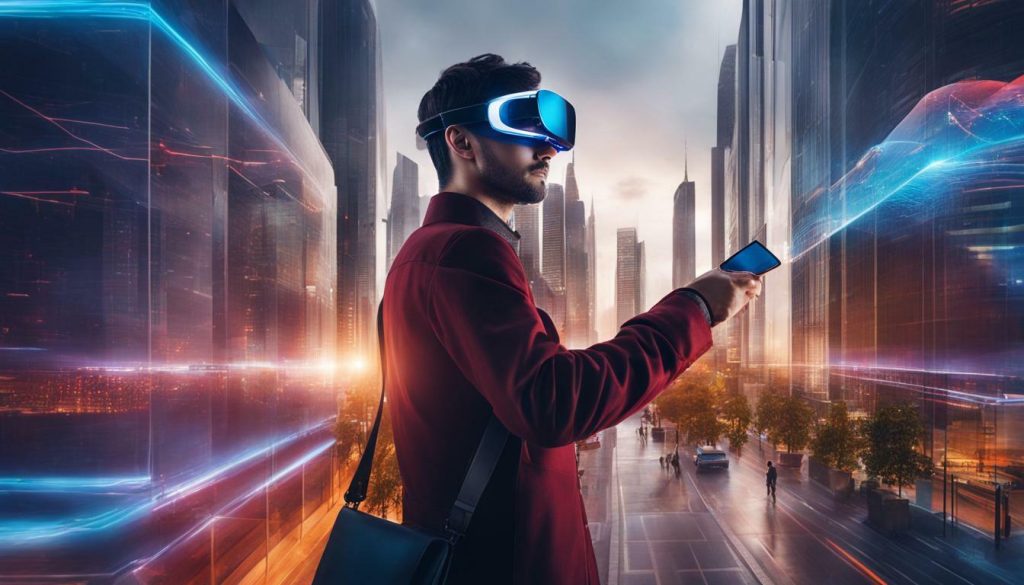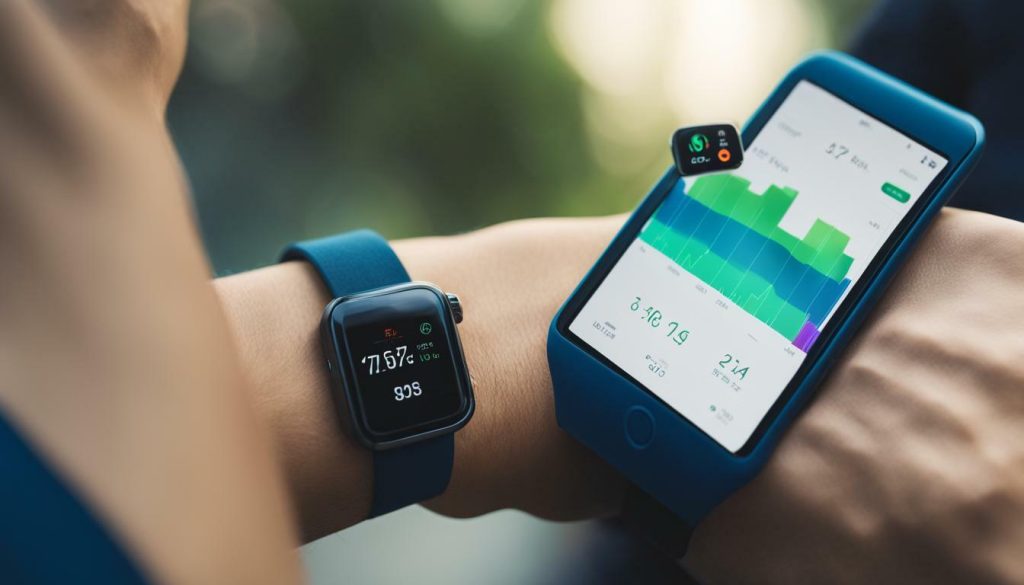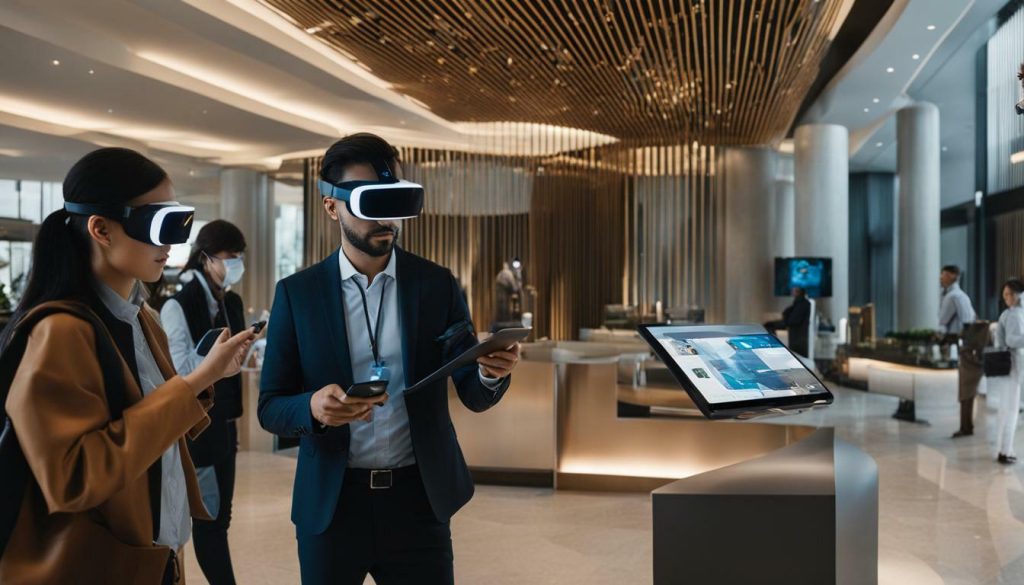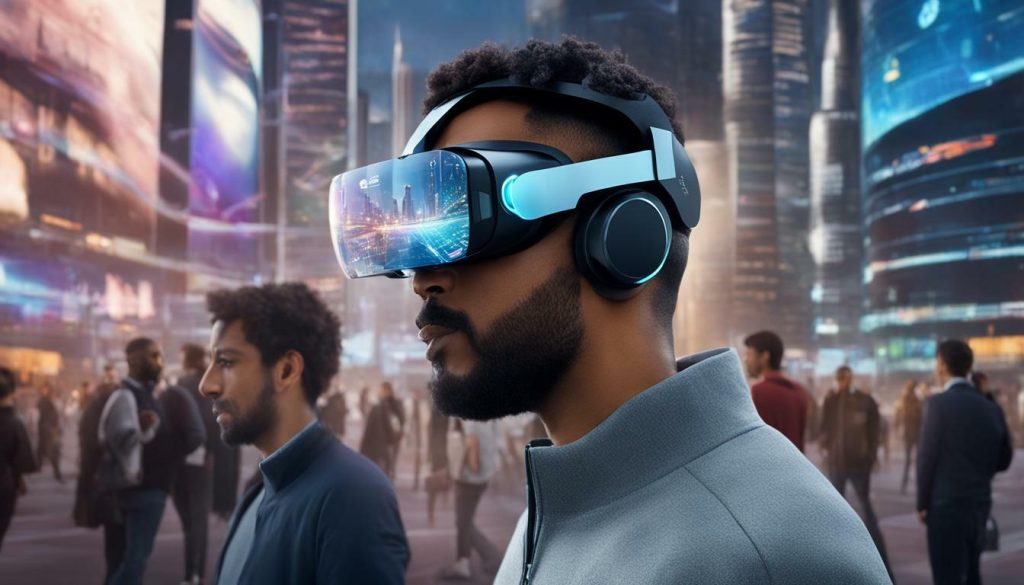Wearable technology has revolutionized the way we live, offering unrivaled convenience and efficiency in our everyday activities. Devices such as smartwatches and fitness trackers have become increasingly popular, providing us with seamless connectivity, health monitoring capabilities, and improved customer experiences.
Whether it’s staying connected without reaching for our phones, tracking our fitness goals, or seamlessly sharing information, wearable technology has become an integral part of our lives.
With applications ranging from smart jewelry and body-mounted sensors to augmented reality and virtual reality headsets, the possibilities are endless.
Key Takeaways:
- Wearable technology offers unparalleled convenience and efficiency in our everyday lives.
- Smart devices like fitness trackers and smartwatches are gaining popularity.
- Wearable technology has advanced from step counters to devices that track activity and keep us connected.
- In the healthcare industry, wearable devices help monitor and manage health conditions.
- The hospitality industry benefits from wearable technology, improving efficiency and enhancing guest experiences.
The Evolution of Wearable Technology: From Step Counters to Smart Devices
Over the years, wearable technology has evolved from basic step counters to sophisticated devices that cater to our diverse needs. Today, wearables have become an integral part of our daily lives, providing us with convenience, connectivity, and enhanced experiences. From fitness technology to augmented reality glasses, let’s explore the fascinating journey of wearable technology and its impact on our lives.
Wearable tech was first introduced with simple devices like pedometers that counted our steps. However, advancements in technology have led to the development of wearable gadgets that offer much more than just step tracking.
Fitness technology has emerged as one of the key areas, with fitness trackers providing real-time data on heart rates, sleep patterns, and calorie consumption. These devices empower individuals to monitor their health and make informed decisions to lead a healthier lifestyle.
| Types of Wearable Technology | Examples |
|---|---|
| Fitness Technology | Fitness trackers, smartwatches |
| Augmented Reality | AR glasses, smart helmets |
| Smart Clothing | Smart jackets, biometric shirts |
Aside from fitness, wearables have also made their way into various industries, including travel, healthcare, and hospitality. For example, the OceanMedallion, a wearable tech accessory used on cruise ships, acts as a key, ticket, and personal concierge, enhancing the overall travel experience.
In healthcare, wearable health devices have revolutionized the way we monitor and improve our well-being. From tracking heart rates to monitoring sleep patterns, these devices provide valuable insights for individuals and healthcare professionals alike.
Looking ahead, the future of wearable technology holds even more exciting possibilities. With advancements in AR and VR headsets, we can expect immersive experiences that blur the lines between the physical and digital worlds. AI hearing aids, smart clothing, and other innovative wearable gadgets will continue to shape our future, enriching our lives and transforming the way we interact with technology.

As wearable technology continues to evolve, so do our expectations and possibilities. From step counters to smart devices, these gadgets have come a long way in enhancing our everyday lives. The future holds endless opportunities for innovation, and it’s up to us to embrace the potential of wearable technology and unlock its full benefits.
Wearable Technology in Healthcare: Monitoring and Improving Our Well-being
Wearable technology has revolutionized healthcare, offering individuals the ability to monitor and improve their overall well-being. With the advancements in wearable health devices, such as fitness trackers, individuals now have access to real-time data about their health and fitness levels.
These devices can track various metrics, including heart rate, sleep patterns, and even blood sugar levels, providing valuable insights to both users and healthcare professionals.
The wearable technology market for healthcare continues to grow rapidly, with an increasing number of people turning to these devices to enhance their health management.
According to Statista, the global wearable devices market size is projected to reach $81.5 billion by 2021. This growth is driven by the rising awareness about the importance of preventive healthcare and the convenience offered by wearable devices in monitoring and managing health conditions.
One of the key benefits of wearable technology in healthcare is the ability to monitor health in real-time. This allows individuals to track their progress towards fitness goals, identify potential health issues, and make informed decisions about their lifestyle choices. For example, a fitness tracker can monitor an individual’s heart rate during exercise, providing immediate feedback on the intensity of the workout and helping them optimize their training.
Furthermore, wearable technology plays a crucial role in the management of chronic conditions. By continuously monitoring vital signs and other health data, wearable health devices enable individuals and healthcare professionals to detect early warning signs, prevent complications, and improve treatment outcomes.
For instance, a wearable device that monitors blood glucose levels can help individuals with diabetes manage their condition more effectively, reducing the risk of dangerous highs and lows.

In conclusion, wearable technology is transforming healthcare by providing individuals with the means to monitor and improve their well-being. With the growing wearable technology market, the potential for innovation in this field is boundless.
As these devices continue to evolve, they will undoubtedly play a crucial role in empowering individuals to take control of their health and lead healthier, more fulfilling lives.
Enhancing Travel Experiences with Wearable Technology
Travel experiences have been transformed by wearable technology, with innovations like the OceanMedallion providing unprecedented convenience and personalization. This wearable tech accessory serves as a key, ticket, and personal concierge, revolutionizing the way travelers interact with cruise ships.
With the OceanMedallion, guests can unlock their cabin doors, make purchases, and access personalized recommendations and services with a simple tap. This eliminates the need for physical tickets, room keys, and wallets, streamlining the entire vacation experience. The medallion is embedded with advanced technology, including Bluetooth and near-field communication, ensuring seamless connectivity throughout the ship.
Wearable technology trends in the travel industry go beyond the OceanMedallion. Smartwatches and fitness trackers have also become popular travel companions, allowing users to track their activity, monitor health metrics, and stay connected while on the go. These devices enable travelers to receive notifications, check maps, and even make contactless payments, all from the convenience of their wrist.
Furthermore, wearable tech accessories like smart luggage tags, GPS trackers, and language translators are enhancing travel experiences and providing peace of mind. These accessories make it easier to locate belongings, navigate unfamiliar destinations, and communicate with locals, making travel more enjoyable and stress-free.
| Wearable Technology for Travel: | Benefits: |
|---|---|
| OceanMedallion | Convenience, personalization |
| Smartwatches and fitness trackers | Activity tracking, connectivity |
| Smart luggage tags, GPS trackers, and language translators | Security, navigation, communication |

- Wearable technology like the OceanMedallion is revolutionizing travel experiences by providing convenience and personalization.
- Smartwatches and fitness trackers allow travelers to stay connected, track their activity, and make contactless payments.
- Smart luggage tags, GPS trackers, and language translators enhance security, navigation, and communication while traveling.
Traveling with wearable technology has never been easier. From unlocking doors to tracking activity, these devices are transforming the way we explore the world.
Improving Efficiency in Hospitality Management with Wearable Technology
The hospitality industry has embraced wearable technology, leveraging it to enhance efficiency and deliver exceptional guest experiences. Wearable tech accessories and smart clothing have revolutionized the way hotels and restaurants operate, streamlining processes and improving customer service.
With the latest trends in wearable technology, hospitality businesses can optimize operations, increase staff productivity, and provide personalized experiences for guests.
One of the key applications of wearable technology in hospitality management is staff communication and coordination. Devices such as smartwatches and earpieces enable real-time communication between team members, eliminating the need for cumbersome radios or intercom systems. Staff can receive instant notifications, messages, and updates, allowing them to respond quickly to guest requests and collaborate seamlessly.
Another area where wearable technology has made a significant impact is guest service and experience. Wearable tech accessories like smart bracelets or key fobs are used as digital keys, enabling guests to access their rooms or facilities effortlessly. This not only enhances convenience but also improves security by eliminating the risk of lost keys or keycards.
| Benefits of Wearable Technology in Hospitality Management | Examples of Wearable Technology |
|---|---|
|
|
Wearable technology also plays a crucial role in inventory management within the hospitality industry. Smart clothing equipped with RFID (radio-frequency identification) tags can track and monitor inventory levels, ensuring efficient stock management.
This technology enables staff to quickly locate items, monitor usage, and automate inventory replenishment processes, reducing waste and optimizing supply chain operations.
In conclusion, wearable technology is transforming the hospitality industry, improving efficiency, and creating memorable guest experiences. From staff communication and coordination to guest service and inventory management, wearables have become indispensable tools in the modern hospitality landscape.
As technology continues to evolve, the potential for innovation in this field is limitless, making wearable technology a game-changer for the future of hospitality management.

The Versatility of Wearable Technology: Applications in Various Industries
Wearable technology finds its place in various industries, from fashion to healthcare, offering endless possibilities and innovation. These smart devices have revolutionized the way we live, work, and interact with the world around us. With advancements in technology, wearables have become more than just accessories; they have become an integral part of our daily lives.
In the fashion industry, smart clothing has taken center stage. From connected jackets that can control music playback to self-adjusting sneakers that adapt to your foot shape, fashion and technology have merged to create functional and stylish wearables. These smart garments not only provide convenience but also enhance our overall fashion experience.
Healthcare has also experienced a significant transformation with the introduction of wearable technology. Wearable health devices, such as fitness trackers and smartwatches, allow individuals to monitor their heart rate, sleep patterns, and exercise routines.
This data can then be shared with healthcare professionals, enabling them to make more informed decisions about patient care. The wearable technology market in the healthcare sector is rapidly growing, with an increasing number of devices catering to different health needs.
Another industry where wearable technology is making a significant impact is entertainment and gaming. Augmented reality (AR) and virtual reality (VR) headsets provide users with immersive experiences, transporting them to virtual worlds and enhancing their gaming experiences. These devices have revolutionized the way we consume entertainment, offering endless possibilities for interactive storytelling and gameplay.
| Industry | Applications of Wearable Technology |
|---|---|
| Fashion | Smart clothing, connected accessories |
| Healthcare | Fitness trackers, smartwatches, health monitoring devices |
| Entertainment and Gaming | AR and VR headsets, immersive experiences |
From fashion to healthcare to entertainment, wearable technology continues to push the boundaries of innovation. As technology advances and new applications emerge, the possibilities for wearables are endless.
Whether it’s tracking our fitness goals, enhancing our gaming experiences, or revolutionizing the way we dress, wearable technology is set to shape the future and continue to improve our everyday lives.

Stay tuned for our next section where we dive deeper into the fascinating origins of wearable technology and how it has evolved over the years.
The Fascinating Origins of Wearable Technology
The fascinating history of wearable technology dates back centuries, starting with inventions like eyeglasses that have paved the way for modern-day innovations. Today, we have come a long way from the simple act of adorning our bodies with functional accessories. Wearable technology, equipped with body-mounted sensors and advanced features, has transformed the way we interact with the world.
Throughout history, humans have sought ways to enhance their abilities through wearable devices. In the 13th century, eyeglasses were invented, revolutionizing vision correction. Fast forward to the 1970s, calculator watches gained popularity, merging timekeeping with functional calculations. These early examples laid the foundation for the multifaceted wearable technology market we see today.
Over the years, wearable technology has evolved and expanded to encompass a wide range of devices. From fitness trackers that monitor our activity and health, to smart clothing that can respond to environmental changes, and augmented reality glasses that blend the digital and physical worlds, wearables have become indispensable in our daily lives.

The market for wearable technology continues to grow, driven by advancements in technology and consumer demand. According to a report by MarketsandMarkets, the global wearable technology market is projected to reach $93.4 billion by 2027, with a compound annual growth rate of 15.9%. This highlights the increasing popularity and importance of wearable technology in various industries.
In conclusion, the origins of wearable technology can be traced back to ancient inventions like eyeglasses. Today, wearables have become an integral part of our lives, enhancing our capabilities and providing us with valuable insights. As technology continues to advance, the future of wearable technology holds immense potential for further innovations that will shape the way we live and interact with the world.
The Future of Wearable Technology: Innovations and Potential
The future of wearable technology holds immense promise, with exciting advancements like AR and VR headsets and AI hearing aids on the horizon. These innovations have the potential to revolutionize various industries, enhancing our experiences and improving our quality of life.
AR and VR headsets, in particular, offer immersive experiences in entertainment, gaming, and even education. They have the ability to transport us to virtual worlds and create interactive experiences like never before.
From exploring distant galaxies to practicing surgical procedures, the possibilities are endless. With their ability to blend the virtual and physical worlds, AR and VR headsets have the potential to transform the way we learn, work, and entertain ourselves.
AI hearing aids are another exciting development in wearable technology. These devices use artificial intelligence to enhance sound quality and provide personalized hearing experiences. They can adapt to different environments, filter out background noise, and even connect to other smart devices. AI hearing aids bring convenience and improved quality of life to individuals with hearing impairments, allowing them to communicate and engage effectively in various settings.
| Advancements in Wearable Technology | Potential Applications |
|---|---|
| AR and VR headsets | Entertainment, gaming, education, healthcare |
| AI hearing aids | Hearing enhancement, personalized sound experiences |
| Wearable gadgets | Fitness tracking, health monitoring, productivity enhancement |
Aside from AR and VR headsets and AI hearing aids, wearable gadgets continue to evolve and offer new functionalities. Fitness trackers, for example, have become an essential tool for monitoring physical activity, sleep patterns, and overall health.
They provide real-time feedback, motivate users to stay active, and help them achieve their fitness goals. Other wearable gadgets also focus on enhancing productivity, such as smart glasses that display notifications, reminders, and important information right in front of our eyes.
As we look towards the future, it is clear that wearable technology will continue to shape our lives in remarkable ways. With advancements like AR and VR headsets, AI hearing aids, and a wide range of other wearable gadgets, we can expect a more immersive, connected, and efficient future. It’s an exciting time to embrace the potential of wearable technology and explore the possibilities it holds.
References:
- Business Insider – “80% of consumers are willing to wear smart fitness technology”

Embracing the Potential of Wearable Technology
Embracing the potential of wearable technology is crucial in unlocking the countless benefits it offers, from smart wearables to innovative wearable devices. Wearable technology, such as smartwatches and fitness trackers, is gaining popularity and enhancing our everyday lives in various ways.
Wearables have advanced from simple step counters to devices that track our activity, keep us connected, and improve customer experiences. They allow us to stay connected without the need to pull out our phones, track our activity, and share our information easily.
The future of wearable technology shows great potential for continued innovation and improvement in various industries. By embracing wearable technology, we can unlock its immense potential and shape a future where convenience, efficiency, and connectivity are seamlessly integrated into our everyday lives.
Join us on a journey of innovation and well-being! Explore our blog for captivating insights at the intersection of health and technology. Your adventure begins here.
FAQ
What is wearable technology?
Wearable technology refers to electronic devices that can be worn on the body, often in the form of accessories or clothing. These devices are designed to enhance our daily lives by providing various functionalities, such as tracking our activity, keeping us connected, and improving customer experiences.
How popular is wearable technology?
According to Business Insider, 80% of consumers are willing to wear smart fitness technology. Wearable technology has gained popularity in recent years due to its convenience and efficiency.
What are some examples of wearable technology?
Examples of wearable technology include smartwatches, fitness trackers, smart jewelry, body-mounted sensors, augmented reality (AR) and virtual reality (VR) headsets, AI hearing aids, and smart clothing.
How does wearable technology impact personal healthcare?
Wearable technology in healthcare can monitor sleep habits, heart rates, and blood sugar levels, providing valuable data for doctors and patients to better understand and manage health conditions.
How does wearable technology enhance travel experiences?
Wearable technology in the travel industry, such as the OceanMedallion, is used as a key, ticket, and personal concierge on cruise ships, enhancing the overall travel experience.
What benefits does wearable technology bring to the hospitality industry?
Wearable technology in hospitality management can increase efficiency and revenue in hotels and restaurants, offering features like personalized service and smart clothing for staff.
What are the origins of wearable technology?
The origins of wearable technology can be traced back to the 13th century with the invention of eyeglasses. Over the years, wearable technology has evolved to include various devices and gadgets.
What is the future of wearable technology?
The future of wearable technology shows great potential for continued innovation and improvement in various industries. Emerging technologies like augmented reality (AR) and virtual reality (VR) headsets and AI hearing aids are expected to shape the future of wearables.
How does wearable technology enhance everyday life?
Wearable technology, such as fitness trackers and smartwatches, enhances everyday life by providing convenience and efficiency. It allows us to track our activity, stay connected without constantly using our phones, and access information easily.
How does wearable technology influence the future?
Wearable technology has a significant influence on shaping the future, with advancements in areas like healthcare, entertainment and gaming, fashion, military, and sports and fitness. It has the potential to revolutionize how we interact with the world.
Why is it important to embrace wearable technology?
Embracing wearable technology is important because it offers numerous benefits and improvements to our daily lives. It enhances convenience, efficiency, and connectivity, allowing us to fully leverage the advantages of modern technology.



